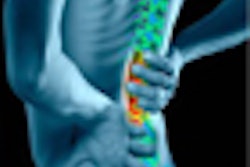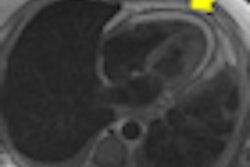The use of cardiac MRI in an emergency department for intermediate- and high-risk patients with chest pain can cut costs and, in some cases, allow patients to return home the same day, according to a study published online in the Annals of Emergency Medicine.
In a comparison of patients who were evaluated with cardiac MRI and patients who received conventional inpatient care, far fewer patients in the cardiac MRI group had to be admitted to the hospital, and their cost of care was $588 lower than the inpatient group, according to researchers at Wake Forest University Baptist Medical Center in Winston-Salem, NC.
The May 31 online study is scheduled to appear in a future issue of the Annals of Emergency Medicine.
Unnecessary evaluation
At issue is a tendency for people with chest pain to be admitted to a hospital and undergo lengthy evaluations, according the study's lead author, Chadwick Miller, MD, assistant professor of emergency medicine at Wake Forest. After these assessments, only a small proportion of patients have serious cardiac problems.
"There is this over-triage, which ends up accumulating a large amount of costs in the use of our resources, so we wanted to see if there is a more efficient way to manage these people and, in particular, manage patients who are intermediate or high risk," he said.
The researchers started with a population of 967 patients who were treated at Wake Forest between January 2008 and March 2009. Patients were eligible for the study if they had intermediate or high probability for experiencing acute coronary syndrome.
The group eventually enrolled 110 patients in the study and randomized them into two groups. One group of 53 patients was directed to the cardiac MRI observation unit, while 57 patients were in the inpatient care group. Eight (7%) of the 110 patients experienced acute coronary syndrome.
Cardiac MRI care in the observation unit of Wake Forest's emergency department was staffed by nurse practitioners or physician assistants and supervised by an emergency physician. Orders included cardiac biomarkers at four and eight hours from the initial blood draw and a stress cardiac MRI examination.
MRI's capabilities
A benefit of MRI is that the modality allows physicians to look at several aspects of the heart during one exam. The MR images can detect cardiac edema, or heart swelling, which is one of the early signs of ischemia or decreased blood flow. Cardiac MRI also views heart motion: A contrast-enhanced cardiac MRI stress test can discover any abnormal areas of blood flow to the heart, and the modality can uncover other damage that may have been caused by a previous heart attack.
"When you put all the pieces together, [cardiac MRI] allows you to tell a nice story about what's going on with the heart, whereas other modalities don't provide all of that information in one exam," Miller said.
In the cardiac MRI observational group, 49 (92%) of 53 patients underwent stress cardiac MRI on a 1.5-tesla MRI scanner (Magnetom Avanto, Siemens Healthcare, Malvern, PA), with 11 (21%) of the 53 patients admitted to the hospital. One patient chose to leave against the advice of doctors, and 41 patients (77%) were discharged. Two people (3%) had acute coronary syndrome.
Among the inpatient care group, 39 (68%) of 57 patients initially received stress testing, with 54 (97%) of the 57 admitted to the hospital. Three patients (5%) left the facility against medical advice, and six patients (9%) were diagnosed with acute coronary syndrome. Those in the inpatient care group most commonly underwent stress echocardiography testing (54%).
After 30 days, no patient in either group experienced acute coronary syndrome after discharge.
Cost calculations
To calculate costs in each group, the researchers used itemized patient charges based on 2008 department-specific cost-to-charge ratios as reported to the U.S. Centers for Medicare and Medicaid Services (CMS). Provider costs were determined by CPT codes from each charged service and physician work relative value units (RVUs) according to the CMS physician fee schedule.
Based on the numbers, the researchers determined that the median direct cost of the hospital visit for patients in the cardiac MRI observation unit was $2,062, compared with $2,680 in the inpatient care group. The estimated median difference between the two groups was $588, ranging from $336 to $811.
"The bottom line is there are reductions in costs that are driven by a reduction in inpatient facility costs," such as the cost of a hospital room, nursing staff, and other support personnel, Miller said. "In our analysis, that appeared to be the largest difference among the two groups."
Length of stay
Though some patients were able to return home the same day after the cardiac MRI evaluation, Miller said there was no dramatic difference in patients' lengths of stay. "These people [in the cardiac MRI group] were on a very set course for their care," he added. "From the time they were in the study, they were on a care algorithm, which was much different than the other [inpatient] group that was based on what their clinician wanted to do, so it was unstructured."
Miller and his colleagues plan to continue the research in this area, and ongoing studies are under way. "Before this is replicated or used in clinical practice," he said, "a study needs to be conducted in a multicenter setting to make sure these findings do hold true and to test safety with a larger number of patients."
By Wayne Forrest
AuntMinnie.com staff writer
June 29, 2010
Related Reading
MRI shows age- and gender-based differences in myocardial motion, December 18, 2009
CT treads MRI turf by diagnosing myocardial edema, December 17, 2009
Cardiac MR techniques improve myocardial assessment, June 15, 2009
Cardiac magnetic resonance can assess at-risk myocardium after MI, June 5, 2009
Cardiac stress MR tops SPECT, showing cause of chest pain, November 30, 2008
Copyright © 2010 AuntMinnie.com



















